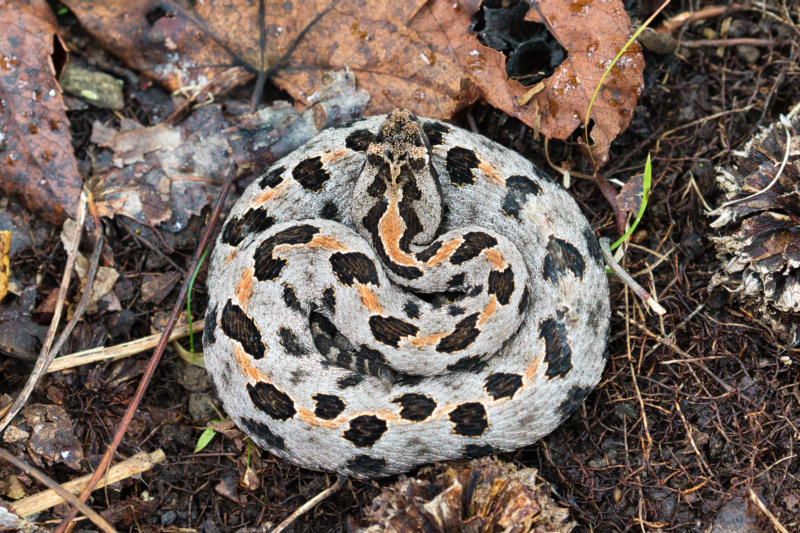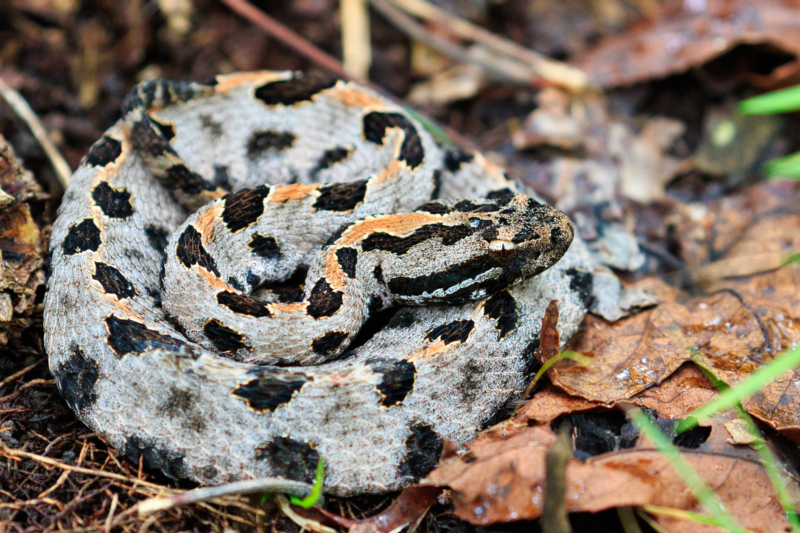Arkansas is home to a diverse array of wildlife, including the elusive Western Pygmy Rattlesnake (Sistrurus miliarius streckeri). This small but fascinating venomous snake is often misunderstood and overlooked due to its size and secretive nature. In this guide, we’ll explore everything you need to know about Western Pygmy Rattlesnakes in Arkansas, from their identification and habitat to safety tips for outdoor enthusiasts.
Understanding the Western Pygmy Rattlesnake
Physical Traits of the Pygmy Rattlesnake
The Western Pygmy Rattlesnake is one of the smallest rattlesnake species in North America, typically measuring between 15 to 20 inches in length. Despite its small size, it packs a potent venom. Key identifying features include:
- Coloration: Gray or light brown with dark, irregular blotches along the back.
- Rattle: A tiny rattle that produces a faint, buzzing sound, often compared to the noise of an insect.
- Head Shape: Triangular, with a distinctive dark stripe running from the eye to the corner of the mouth.
For more detailed information on the species, check out this comprehensive resource from Herps of Arkansas.
Behavior and Diet of the Small-Scale Rattlesnake
Western Pygmy Rattlesnakes are ambush predators, feeding primarily on small rodents, lizards, and insects. They are generally shy and non-aggressive, preferring to rely on their camouflage to avoid detection. When threatened, they may rattle their tails as a warning, but they rarely strike unless provoked.
Habitat and Range of the Pygmy Rattlesnake in Arkansas
Preferred Environments for the Western Pygmy Rattlesnake
Western Pygmy Rattlesnakes thrive in a variety of habitats, including:
- Woodlands: Dense forests with ample ground cover.
- Marshes and Wetlands: Areas near water sources, such as swamps and riverbanks.
- Rocky Outcrops: Sheltered spots that provide hiding places and basking opportunities.
In Arkansas, they are most commonly found in the southern and eastern regions of the state, where these habitats are abundant.
A Personal Encounter: Spotting a Pygmy Rattlesnake in the Ouachita National Forest
While hiking in the Ouachita National Forest last week, I came across a small snake coiled up next to the game trail I was following. It turned out to be a Western Pygmy Rattlesnake, a species native to Arkansas that is often misunderstood by humans. This encounter was a reminder of how well these snakes blend into their surroundings and how important it is to stay alert while exploring their habitat.


Seasonal Patterns of the Pygmy Rattlesnake
These rattlesnakes are most active during the warmer months, from late spring to early fall. During the winter, they enter a state of brumation (similar to hibernation) in underground burrows or rock crevices.
Are Western Pygmy Rattlesnakes Dangerous?
Venom and Effects of a Pygmy Rattlesnake Bite
While the Western Pygmy Rattlesnake is venomous, its bite is rarely fatal to humans due to the small amount of venom it injects. However, a bite can cause pain, swelling, and other localized symptoms. Seek medical attention immediately if bitten.
Safety Tips for Avoiding Pygmy Rattlesnake Encounters
To minimize the risk of encountering a Western Pygmy Rattlesnake, follow these safety tips:
- Stay on Trails: Avoid walking through tall grass or dense underbrush where snakes may be hiding.
- Wear Protective Footwear: Sturdy boots can provide an extra layer of protection.
- Be Observant: Watch where you step or place your hands, especially near rocks or logs.
- Do Not Disturb: If you spot a rattlesnake, give it plenty of space and do not attempt to handle it.
Conservation Status of the Western Pygmy Rattlesnake
Threats to the Pygmy Rattlesnake Population
Western Pygmy Rattlesnakes face several threats, including habitat loss due to urbanization and road mortality. Additionally, they are often killed out of fear, despite their ecological importance.
Ecological Role of the Small-Scale Rattlesnake
As predators, Western Pygmy Rattlesnakes play a vital role in controlling populations of rodents and other small animals. Their presence is an indicator of a healthy ecosystem.
How to Coexist with Pygmy Rattlesnakes in Arkansas
Educate Yourself and Others About Pygmy Rattlesnakes
Understanding the behavior and habitat of Western Pygmy Rattlesnakes can help reduce unnecessary fear and promote coexistence. Share your knowledge with others to foster appreciation for this unique species.
Support Conservation Efforts for the Western Pygmy Rattlesnake
Consider supporting local wildlife conservation organizations that work to protect rattlesnakes and their habitats.
The Importance of Western Pygmy Rattlesnakes in Arkansas’s Ecosystem
Role in Controlling Rodent Populations
Western Pygmy Rattlesnakes are essential for maintaining the balance of Arkansas’s ecosystems. By preying on rodents, they help control populations that could otherwise become pests, damaging crops and spreading disease.
Indicator Species for Environmental Health
The presence of Western Pygmy Rattlesnakes is often an indicator of a healthy, biodiverse environment. Their decline can signal broader ecological issues, making their conservation crucial for the overall health of Arkansas’s natural habitats.
Myths and Misconceptions About Western Pygmy Rattlesnakes
Myth: All Rattlesnakes Are Aggressive
Contrary to popular belief, Western Pygmy Rattlesnakes are not aggressive. They prefer to avoid confrontation and will only strike if they feel threatened or cornered.
Myth: Pygmy Rattlesnakes Are Not Dangerous
While their bites are rarely fatal, Western Pygmy Rattlesnakes are still venomous and should be treated with respect. Understanding their behavior and habitat can help prevent unnecessary encounters.
Conclusion
The Western Pygmy Rattlesnake is a fascinating yet often misunderstood resident of Arkansas. By learning to identify this species, understanding its habitat, and practicing safety measures, we can coexist with these remarkable creatures while appreciating their role in the ecosystem. Whether you’re a hiker, wildlife enthusiast, or simply curious about Arkansas’s natural heritage, this guide equips you with the knowledge to navigate the world of Western Pygmy Rattlesnakes safely and responsibly.
By following this guide, you’ll not only gain a deeper appreciation for Arkansas’s wildlife but also contribute to the conservation of this unique species. Stay informed, stay safe, and enjoy the natural beauty of the Natural State!
